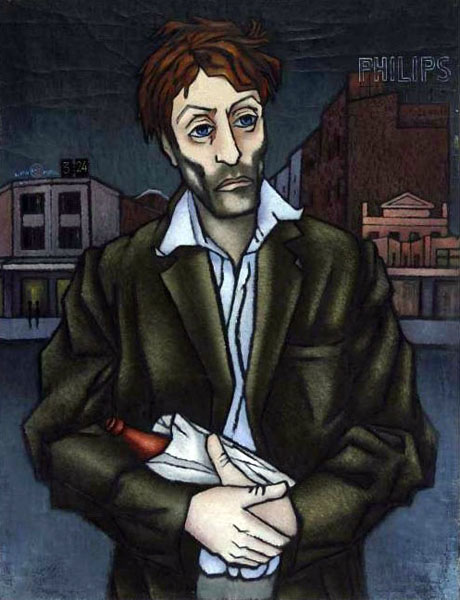1951-71
Arkley was born on 5 May 1951, and first lived with his parents in a stucco house in the outer Melbourne suburb of Box Hill (photo: Spray 10). His younger brother Robert was born in 1955, and the following year the family moved to a larger weatherboard house in Surrey Hills, not far from where John Brack lived. Arkley was educated at Surrey Hills State School and Box Hill Technical College. His father Robert (known as Jack), who worked in the stationery business, died in 1977, when Howard was still only in his mid 20s.
For further details on Arkley’s childhood, see Duncan 1991: 15, Spray 10-11, and the discussion in Preston 2002 (relying particularly on Arkley’s mother Gwen, an ardent supporter of her son’s career). These references include various stories about the artist’s early aptitude for art, and significant early influences. A key stimulus was a Sidney Nolan retrospective held at the NGV in 1967, which apparently spurred Arkley to start painting seriously (see Duncan 1991: 15, where the Nolan show is dated incorrectly to 1966; and Spray 10-11). Several enamel on masonite paintings date from this period: e.g. Figure in Jungle, ill. Spray 11 (dated 1967).
In 1968, he saw The Field exhibition which launched the new St Kilda Road National Gallery building (see Duncan 1991: 15); Arkley’s library includes a well-thumbed copy of the catalogue of this exhibition, showcasing abstract style. However, at this early stage it was Surrealism in particular that inspired him (see comments in Spray 11 and Carnival 161ff.), an influence clearly evident in extant works on paper, e.g. One Person and Two Spirits 1968, and Untitled (Homage to Scotty {sic} Wilson) c.1968-69, both reproduced in Spray 12; the latter was possibly exhibited in 1989 at 200 Gertrude Street in a group exhibition (‘The Intimate Object’), as ‘Schoolboy Art [Homage to Scottie Wilson]’). Other comparable examples are extant in Arkley’s archive.
In 1969, he commenced TOP study at Prahran CAE; several works on paper in the artist’s archive date from this period (inscribed IC; some dated 1969).

[untitled architectural drawing from student folio labelled ‘1c’ (1969?)]
Later, he recalled seeing a Ti Parks exhibition at Tolarno, St Kilda in 1969 (see Duncan 1991:15). This experimental show included a Dada-esque ‘sculpture of total environment’, entitled Virginia’s; ‘basically described, this was the stretcher of a large painting (minus the painting)’ (Margaret Plant, Irreverent Sculpture, Monash University Gallery, 1985, p.64). This conceptual piece possibly influenced Arkley’s own later installations.
But at this early stage of his developing career, he was still working mostly under the influence of Surrealism, to judge from an untitled painting on canvas, 83.5 x 65 cm, signed and dated 1969, auctioned by Deutscher-Menzies, Melb., 29-30 Nov.2000 (lot 94A,with reproduction; see also slide in Arkley’s archive, with process date Dec72). Further collaged works on paper also in the lineage of Surrealism date from this period, e.g. a collage showing a shadowy figure and a train (reproduced in Duncan 1991:15 and Spray 13).
He also evidently tried his hand at more conventional painting around this time, to judge from an oil portrait of Melbourne identity Brett Lea, signed by Arkley and dated 1970? (sold by Sotheby’s, Melbourne, 28 Nov.2005, lot 184: reproduced in the auction catalogue, noting a Tolarno provenance).

[Portrait of Brett Lea (1970?), auctioned in 2005]
Shortly after beginning his Diploma in Painting in 1970, Arkley discovered the air-brush that would later become his signature method, apparently through the prompting of noted painter Fred Cress, who was teaching at Prahran CAE at the time (see Rooney 1981 and Duncan 1991:15). Later in 1970, Arkley held his first significant exhibition at Ann’s Garrett Gallery, 280 Chapel Street, together with fellow Prahran student Andrew Hicks; according to the 1969-75 biography in the artist’s archive (see also Duncan 1991:31), he showed ‘13 hardedge collages’; examples of works in this style are extant in Arkley’s studio collection. His drawing skills were praised in a brief review of the Ann’s Garrett Gallery exhibition by respected critic Alan McCulloch (1970).
Arkley continued his Diploma at Prahran CAE in 1971, entering works for several prizes, including a shaped canvas called Section Off, for the Flotto Lauro Prize, The Age Gallery (see HA Bio.1969-75 and Duncan 1991: 15). In which do you belong, an unidentified painting described as 6 feet square, was submitted to the Corio 5 Star Whisky Prize, Geelong Art Gallery (unfortunately the Geelong Gallery have no record of this work). He also submitted a folio of eight drawings for the NGV Drawing Prize for 1971 (details uncertain).
A painting on black cardboard, sprayed in blue-green tones, is reproduced in Spray 14 as ‘Untitled 1971’; the work, measuring approximately 51 x 63.5 cm, is preserved in Arkley’s archive, together with a slide of it labelled ‘Winged’, with process date Nov73.